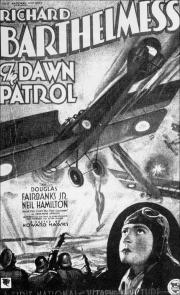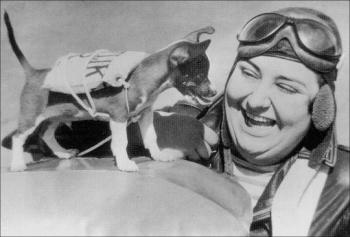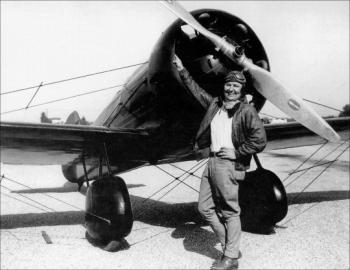 |
Pancho did stunt flying in Dawn Patrol |
Pancho Barnes
By |
Pancho did stunt flying in Dawn Patrol |
From time to time, the human race produces unique, one-of-a-kind characters who become our heroes, mentors, celebrities, and geniuses. Pancho Barnes played all the roles with her own brand of conformity. She possessed an extraordinary zest for life, an unquenchable thirst for adventure, and a profound curiosity of the unknown. Although she involved herself in a diverse mixture of careers and interests, she gained the most notoriety for her accomplishments and exploits in aviation – the avocation to which she dedicated her life. It was there among the flyers, that she found a family.
Born in 1901 in Pasadena, California, Pancho inherited wealth, status, and privilege. Her paternal grandfather was Professor Thaddeus Lowe who volunteered the use of his air balloons to President Lincoln during the Civil War.
Most of Pancho's youth was spent on horseback in the company of her father or grandfather. The professor took his favorite granddaughter to every aviation event in Southern California and inspired her with dreams of flight. Mr. Lowe taught Pancho all there was to know about animals.
 |
Pancho and her little chiuahua ready for the Transcontinental
Derby |
Two years after graduating from Bishop’s School in La Jolla, California, Pancho entered into an arranged marriage with Reverend Rankin Barnes. The handsome clergyman reminded her of the romantic movie idols she often watched during Saturday afternoon matinees. It was not a match made in heaven, however. Rankin’s salary was meager and his nature sterile and antiseptic. Pancho made an honest attempt at being a good wife for three years. In 1924 she gave up her arduous task.
Pancho found numerous jobs in the film industry, from electrician to stunt rider. Her salary enabled her to hire a nurse for her son, Bill. This, in turn, freed her to travel. On one Mexican adventure, she acquired her nickname. In 1927, Pancho remodeled her San Marino home and began a tradition of lavish parties for her society, movie, and aviation friends. One year later, Pancho took up flying. She formed the Pancho Barnes’ Circus of the Air, giving Sunday afternoon performances at the many fields that dotted the Los Angeles Basin. She entered the first Powder Puff Derby I August 1929. Soon after she became the first woman to fly into the interior of Mexico and set several woman’s speed records.
 |
Pancho Barnes poses with her Travel Air Mystery ship |
In 1934, Pancho traded an apartment building in Hollywood for a ranch near what is now Edwards Airforce Base. She grew alfalfa, raised goats, cows, and hogs, and provided rest and recreation for the Army Air Corps. She supplied instructors and planes for the Civilian Pilot Training Program in 1940.
During World War II, Pancho’s ranch and restaurant saw a steady clientele. Its location, glamorous hostesses, and outrageous owner were responsible. To make her business more exclusive, she called it the Happy Bottom riding Club and passed out membership cards. Scandalous rumors of a brothel began to spread as a result of the scintillating name. Pancho denied innuendoes that she was a madam, stating that whatever the girls did on their on time was their own business.
Edwards Air Force Base initiated an expansion program in 1951. Their plans included a 10 mile runway to accommodate supersonic aircraft and Pancho’s club lay right in it’s path. She knew her business was doomed but gave the government a fight they would never forget. She sued them and won almost $400,000 in an inverse condemnation proceeding. The government took possession of her property.
Pancho relocated some 30 miles to the north in Cantil. She intended to open another club but the location, timing, and money were not adequate. For nearly a decade, the former aviatrix lived in a state of near poverty, survived life-threatening illnesses, and went through a nasty divorce from her last husband. In 1968, her son Bill purchased her Mystery Ship at an aircraft auction. This one single event inspired Pancho to take flying lessons and renew her friendships with her aviation friends. Further, everyone wanted to meet the aging speed queen. There were rounds of parties, recognition, and awards. When Pancho died of heart failure in 1975, her life had come full circle.
The author of this article, Barbara Hunter Schultz, is also the author of the book titled Pancho, The Birography of Florence Lowe Barnes. It was published by Little Buttes Publishing Company in 1996.
When I read this book I must say I was quite moved by the story of
Pancho Barnes and her adventures in life. Barbara has written a wonderful book which not
only tells of Pancho's life but early aviation in the United States. I recommend it to
everyone.
Send email to Echowebmaster@aaaim.com to report any problems.
Last modified: February 12, 1999
No part of this paper may be
reproduced in any form without written permission from:
Jake Brouwer
All articles and photos were provided by:
Land-Sea Discovery Group
Copyright © 1999